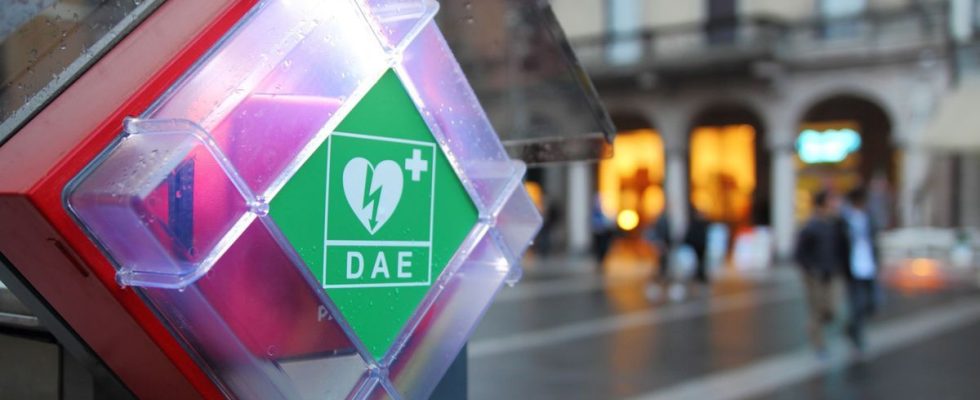Published on
Updated
Reading 3 mins.
Who says vital emergency, says importance of every minute spent rescuing the victim to increase their chances of survival, and reduce the risk of sequelae. And the defibrillator is one of the three gestures that can prove decisive in saving a life. However, a new study by researchers based in the United Kingdom reveals that these electrical devices are only used for 10% of cardiac arrests that occur outside the hospital setting.
Calling the emergency services, whether it is the emergency medical aid service (SAMU) or the fire brigade, performing cardiac massage, and using a defibrillator, are the three reflexes to adopt as a priority – as far as possible – when faced with cardiac arrest. These basic gestures to perform while waiting for help can save lives, and the deployment of defibrillators in many countries, including France, for more than fifteen years, is supposed to help fight against sudden death by cardiac arrest, as the French Ministry of Health recently reminded.
If we know the number of defibrillators installed on the territory, it is more difficult to determine the frequency with which they are used. That’s the question a team of researchers from the Essex Cardiothoracic Center (CTC) and Anglia Ruskin University (ARU) answered today, revealing that defibrillators are only used in one in ten cardiac arrests when these are available… In the East of England at least.
The need for first aid training
Presented at the British Cardiovascular Society Conference, held until June 7 in Manchester, the study is based on data from the East of England Ambulance Service and The Circuit, the national network of defibrillators set up by the British Heart Foundation (BHF). Once this data was acquired, the researchers determined the density of defibrillators in each geographical area, then the number of cardiac arrests, and the frequency of use of said defibrillators between the months of April and September 2022. And the verdict is without appeal. While 1,649 cardiac arrests occurred in the East of England during the given period, and defibrillators were available within 500 meters in 79% of cases, only 10% were used to increase the chances of victim’s survival.
Faced with these results, the researchers recall the importance of raising public awareness of the use of defibrillators, and of promoting training in first aid gestures. “Our study highlights a surprisingly low number of publicly available defibrillators being used in cardiac arrest in the East of England, suggesting that much more needs to be done to promote awareness and education about the cardiopulmonary resuscitation and defibrillation. It is also concerning that there are far fewer defibrillators in the most disadvantaged areas – such a finding should stimulate further discussion on the more consistent and effective installation of defibrillators in communities.“says Dr Thomas Keeble, Consultant Cardiologist at the Essex CTC, in a press release.
Fewer defibrillators in disadvantaged areas
This is the second point, and not the least, revealed by the study. This suggests that disadvantaged areas have four times fewer – and even slightly more – defibrillators than in the whole of the East of England. For example, Luton, the most disadvantaged town in the geographical area studied, has 16 defibrillators per 100,000 inhabitants, compared to 72 for the average in the East of England.
“Rapid cardiopulmonary resuscitation and defibrillation by bystanders can mean the difference between life and death, and it is therefore concerning to see the low rate of use of defibrillators. There are many known reasons for the low use of defibrillators, including not having enough first aiders available at the scene of an emergency, difficulty accessing a defibrillator when it is needed, or fear of using it More needs to be done to encourage people to use these lifesaving devices when they are available,” said Judy O’Sullivan of the British Heart Foundation.
While it is impossible to apply these data to other areas of the world, it generally appears that the presence of defibrillators increases the rate of survival from cardiac arrest, all the more so if the population concerned is trained in first aid. This is the case of the city of Seattle, and the county of King, in the State of Washington in the United States, champion in the matter with a cardiac arrest survival rate that reached 62% in 2013 – and equally high rates of cardiopulmonary resuscitation training for local residents.
In France, according to the French Federation of Cardiology (FFC)about 40,000 people suffer a cardiac arrest each year, and the survival rate is estimated at 8% at most. The French Red Crosswhich offers training and introduction to first aid, indicates for its part that barely more than 40% of French people are trained in these crucial gestures – one of the lowest rates in Europe, far from the 80% set by the government from 2018.
